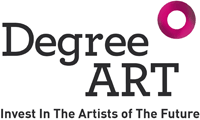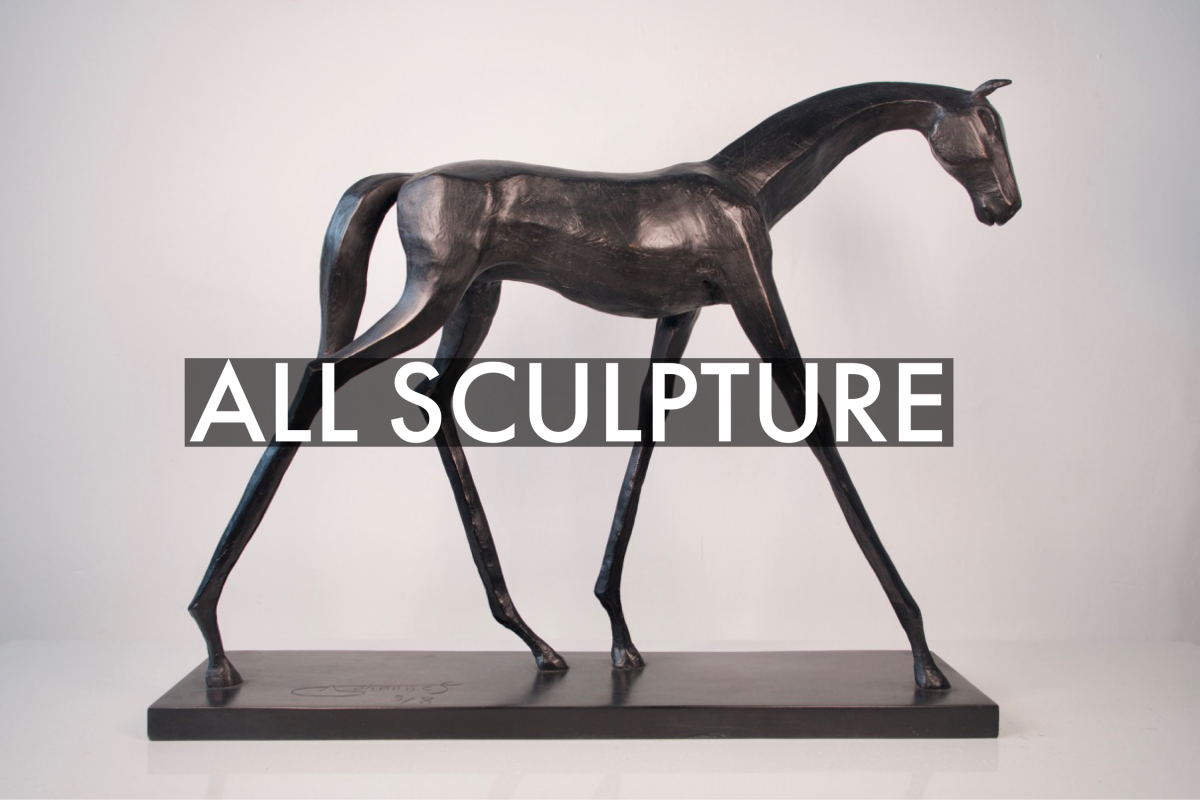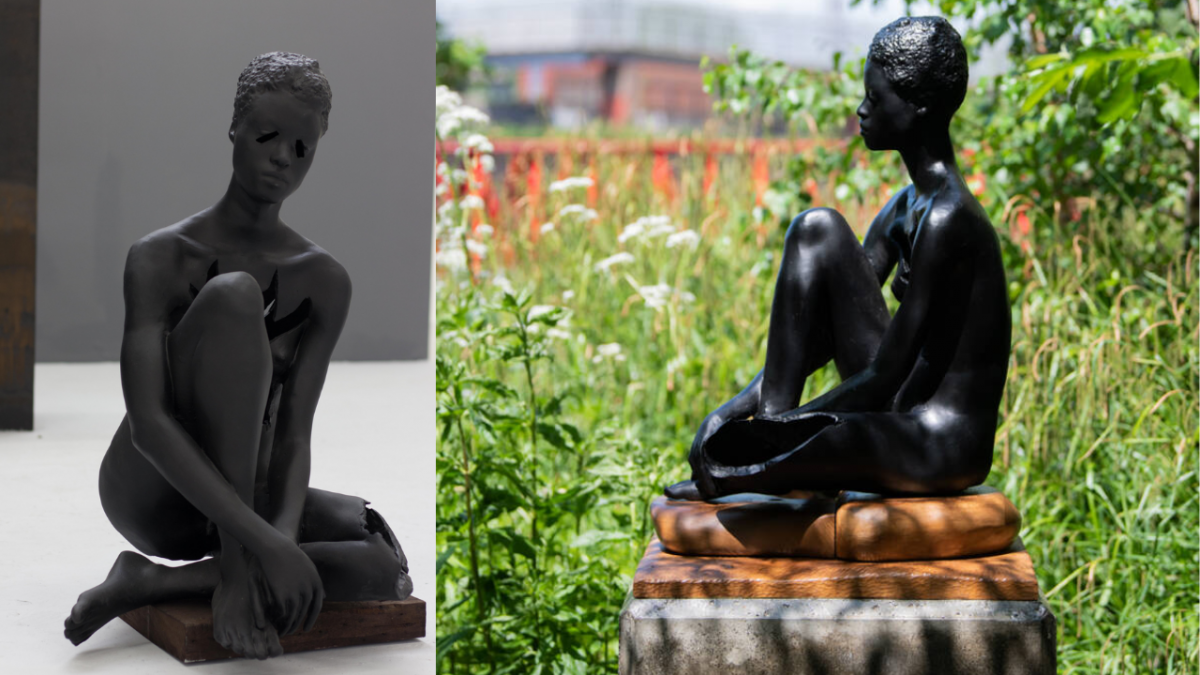THE INTERVIEW
by Jamie Knox and Jamie Knauf
Could you discuss your preferred materials and techniques and how you select them?
"I don't really have a preferred material. I like to explore a wide range of materials. I was drawn to art because the materialistic aspect of it. I started off painting, then I moved to doing little blocks of resin wax and got into animation and 3D design, before landing on ZBrush, which is where I initally create my work."
Tell me about your artistic process. What inspired you to incorporate 3D design into your practice?
"Initally, I ended up with 3D images, from what were once photographs and paintings. I create Rorschach images, usually from photographic imagery, paint and ink, when I'm wanting to get rid of feelings. I freely 'do my thing', creating impressionistic strokes and marks and then examine the mark making to see what forms and patterns emerge. I then come back to a creative space where I have to be calculated and project from the images and try to get something from those renderings. Now, using ZBrush, I 3D scan each figure model, and then create a mesh from which I start editing the image the way I want by putting blocks, shapes and so on to create the desired effect. It allows me to be free. I don't like to feel restricted."
How has your style or approach to sculpture evolved over time?
"In terms of materials, I wouldn't say bronze is my final destination, but it is something that I landed on comfortably, and it seems to be meshing well with my subject matter. I like the idea of not being restricted to one specific technique, the 3D designing and then printing as well. I get so much out of it, I'm not trained as a sculptor in terms of classic ways of creating clay, whihc then leads to the bronze stage, so that in itself is an advantage, I guess. Technology has come so far that we have the freedom to do more. We're not limited. I guess it's due to my environment as well and the things I've been doing, why I end up where I've ended up. Going to City & Guilds of London Art School, that's where I did my MA. And that's where I actually started my bronze, because my BA was all painting. During my MA, I was going between glass work, and I was going between prints. And I was the only one in the foundry. It was the only domain that was virtually empty and I just felt immediately comfortable. It's just one of those things where I end up in this space and I start to experiment with things. I played with photography as well, I started taking photographs of people, a random stranger off the street and then used to project Rorschach images on them and the photography itself looked amazing... I saw something else that caught my intrigue and I wanted to play a bit more with that. It's that accidental thing where you did something, it's great, then something else happened. It's that evolving door that keeps on moving."
What artwork are you most proud of?
"The first one I ever did was Sacrilege. That's the first print I ever created and that was a milestone for me within the practice. In terms of being proud, it diminishes with the process of each piece. I try to stay faithful, but I understand that I put a lot of love and a lot of time and investment to create that piece, but once it's had its light, for me, it's on to the next one and that's what I'm really thinking about. I get a buzz from creating something else. The light goes off. Blur Line would be the one for me... We used to have debates in school. We talked about the politics, the male gaze and so on, and [Blur Line] completely encompassed that, the male gaze. The model I knew, she's a friend of a family member and I knew how her body changes throughout her teens and so on… She went and had breast implants. So I had the before and after images, and it quite drastically changed how sexualized the body has become when it's been manipulated that like. I wouldn't say I preferred her body before and I wouldn't say I prefer it after, it's not my place to prefer. It's for her to feel comfortable in her skin, that she wants to wear. But that left something with me. I don't know what it is specifically. My intention wasn't to cut out her eyes. I think I cut out her eyes, I cut out her private part, I did quite a few cutouts on her waist too, things that women tend to be eating away. It's like their head over their body, always in this turmoil argument in your head and I don't think that ever goes away. But it wasn't deliberate when I was cutting away. When I was projecting the [Rorschach] image on the figure, the darkest areas is what I cut away, and it just happened to be those areas. And I guess, with Rorschach being psychological images, it tends to leave questions about where the mind goes and there's always underlining debates to be had there."
Can you share with us the inspiration and creative process behind Nucleus, the bronze sculpture placed in London City Island?
"The model that I was using, she's a professional model, I accidentally met her on the street, and when she was dressed up, she didn't really look a particular way. But she did have this kind of innocence, this kind of angelic look, and I just thought that will be something. You can read between the lines when you look at imagery, so you can always put them in categories. And that's what I've been doing. When I saw her, I immediately thought, “Okay, this could be something different.” I don't immediately have subject matters in mind, it's just when I see someone I just think, “Okay, this person could be a great muse”. So I asked her and she did the 3D scan. There was quite a few poses done of her, but I never had a seated pose. And I thought that would be interesting because everyone I've used so far has always been standing and to be honest, there was always limitation with the scan because even though it has advanced greatly there's still limitation… you can edit and build someone on the software, but I just liked this notion that you could copy someone--a real person--and then do something. It's like an in-out in-out situation. It's just going along with the process and how it evolved. There was quite a few seated poses that I got, but that particular pose looked a angelic, peaceful, calm, and I wanted to disturb that calmness. I don't think I did. That was Rorschach projected, but I didn't like how it was tearing the figure up. So I just brought it down to this small thing in her chest and it ended up being cut out in our chest. I didn't want to disturb the peace she had. But then again, there's always chaos. Art is always in turmoil. But when I was thinking about it, it was discovered I didn't want to disturb her beautiful, soft, peaceful aesthetic. The foot happened because it was an accident in the casting process. So basically I have to go through all these processes where after I create the wax, I put some ceramic shelling on the piece. And these are really heavy and it takes a toll. Anyway, the ceramic shell creates a shell around to catch the bronze and so it didn't completely go through. Which I would say that was a good mistake that happened. I was contemplating fixing the problem, but then I said no and I went with the flow. It was like fate saying no, let's not be too particular about this."
How do you cope when faced with artist block or other artistic challenges?
"In an artist block situation, once it comes, I'm not saying I don't get those, I do and I get the camera and just start taking photographs and get my head back around and do that kind of art dance I usually do where I just take images, merge them, and then try to get something from it. I'm not saying that there won't be a time when I don't get anything out, or that I won't suck all the juice from that idea, or that process, it's just something that's currently working for me and I haven't really met that block in this process yet. [But], how long will that be? Who knows, hence why I said I keep on trying to explore different avenues. For me, when you get butterflies doing something new, that is the thing I kind of always consistently try to... I don't really go after critiques from the viewers. I go off the buzz I get when I'm trying to make something new and I see it I've done something good. I do care what other people think, but if I constantly wrap my head around other people's positive and negative, I would never be my own individual self to create things that I want to. I will always try to please everyone else. But I think because my mindset is the way it is, I tend to feel that once I'm pleasing myself, everything just falls into place."
What is your key piece of advice for artists embarking on a fine art or creative degree today?
"It can be challenging to find your own style… keep on pushing true. You will come across negativity, obviously, people will be negative and positive towards whatever you create. It's just knowing yourself and pushing through. Because if art was the same, if everyone created the same thing, art wouldn't be what it is. We wouldn't have this culture that we have and this versatility in terms of design, or architecture, or anything, if we all think the same. So I mean, it's just keep on pushing through. If you've got an idea, and you are happy with your ideas, and you think that it's a contribution to your society, then the strain is worth it."
What would you like to accomplish in the coming year with your practice?
"I'd like to create a good body of work. I've started incorporating cement and concrete. This my first time working with the material. It's supposed to be realistic alongside surrealistic, kind of same element as the bronze. So it's something I'm still exploring. I have my intention to create at least six bronzes. I want to create two glass pieces. I'm still looking for the space to do that. But it depends, it can be quite pricey to create glass pieces. I want to create at least 10 pieces, give or take from the cement concrete to the bronze and the glass piece. The glass piece isn't set in stone yet because of my budget do the stuff I need to do in that area, but if I can find anything reasonable, I will move forward with these sculpture plans."
To discuss purchasing, commissioning or any other enquiries regarding the artist, please contact Gallery Director Isobel Beauchamp: Isobel@DegreeArt.com / 07708 251 687.
















